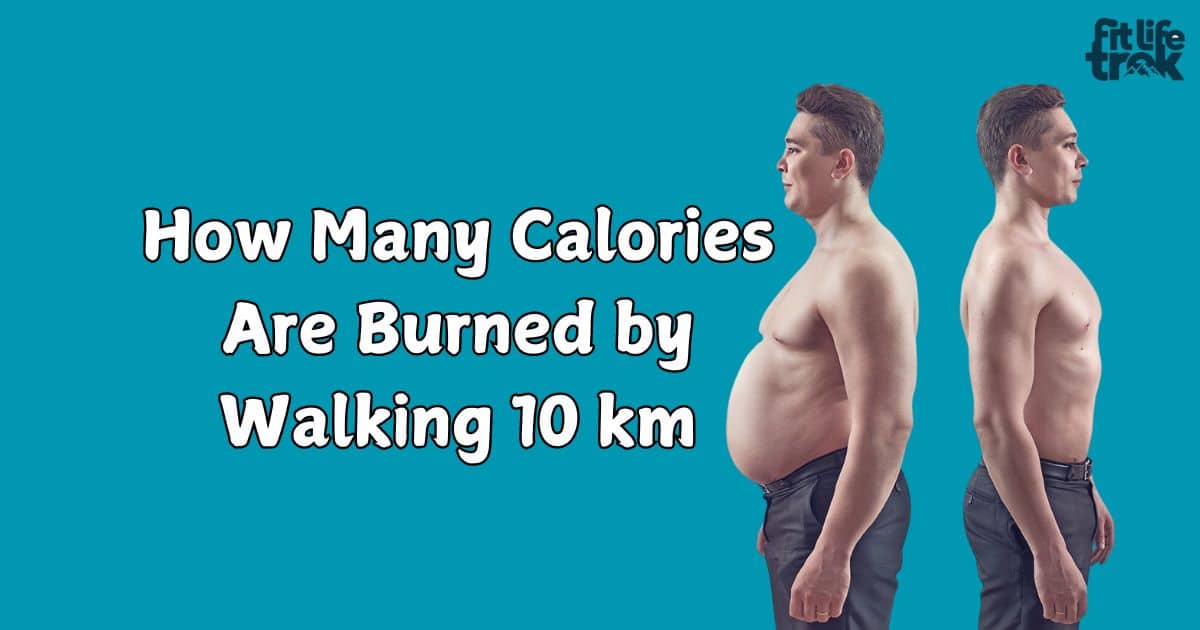Walking is a simple and effective way to stay healthy. It helps your body burn calories, making it a great way to manage weight. When you walk regularly, your heart gets stronger, and your muscles become more active. Walking 10 km each day can make your body stronger and boost your energy. It’s a good way to keep fit without needing special equipment.
Walking also helps the mind. Moving your body improves your mood and reduces stress. When you walk outside, you get fresh air, which makes you feel better. It’s important to wear comfortable shoes and drink water while walking. Walking every day can help build a strong habit that supports both your body and mind.
Each step brings you closer to your goal. Walking faster helps you burn more calories and reach your fitness targets quicker. In the next sections, I’ll uncover the benefits of walking 10 km and how it affects calorie burn.If you want to know more about the calories burned during a 10 km walk, keep reading and discover how this simple activity can impact your health.
How Many Calories Burned by Walking 10 km with Our Calorie Count Guide
Walking 10 km isn’t just a stroll in the park – it’s a serious workout that can torch some serious calories. The number of calories burned depends on factors like your weight, walking pace, and terrain. On average, a 160-pound person can burn about 600-700 calories walking 10 km.
But don’t just take our word for it! Our calorie count guide will help you figure out exactly how much you’re burning. Remember, the faster you walk, the more calories you’ll burn. So lace up those sneakers and let’s get moving!
It’s important to note that everyone’s body is different, and factors like metabolism, muscle mass, and even the weather can affect how many calories you burn. Our guide provides a solid starting point, but listening to your body and tracking your progress over time will give you the most accurate picture of your calorie burn.
Read More About : How Many Steps in 100 km? Counting the Wins of a 100 Km Walk
Calories Burned Walking 10 km?

When it comes to calories burned walking, the numbers can vary widely. A 130-pound person might burn around 500 calories, while a 200-pound person could torch up to 800 calories on the same 10 km walk. That’s a big difference!
Here’s a handy table to give you an idea:
| Weight (lbs) | Calories Burned (10 km walk) |
| 130 | 500 |
| 160 | 600 |
| 200 | 800 |
| 240 | 950 |
Remember, these are just estimates. Your actual calorie burn might be higher or lower depending on your walking pace and the terrain you’re covering. For example, walking uphill or on a sandy beach will burn more calories than walking on a flat, paved surface.
To get a more accurate estimate, you can use a heart rate monitor or a fitness tracker that takes into account your personal data. These devices can provide real-time feedback on your calorie burn, helping you to optimize your workouts and reach your fitness goals faster.
How Long Does It Take to Walk 10 km?
The time it takes to walk 10 km can vary based on your walking pace. An average walking pace is about 5 km/h, which means it would take about 2 hours to complete 10 km. If you’re up for a challenge, try a brisk walking pace of 6 km/h, and you’ll finish in about 1 hour and 40 minutes.
Don’t worry if you’re just starting out. A slower walking pace of 4 km/h is perfectly fine, and you’ll complete your 10 km in about 2 hours and 30 minutes. The key is consistency, not speed. Keep at it, and you’ll see improvements in no time!
Here’s a breakdown of different walking paces and their corresponding times for a 10 km walk:
| Walking Pace | Time to Complete 10 km |
| 4 km/h | 2 hours 30 minutes |
| 5 km/h | 2 hours |
| 6 km/h | 1 hour 40 minutes |
| 7 km/h | 1 hour 25 minutes |
Remember, it’s not about being the fastest walker out there. It’s about finding a pace that challenges you but is still sustainable for the full 10 km. As you build your fitness, you’ll naturally find yourself walking faster without even trying!
How Long Does It Take to Run 10 km?

If you’re feeling ambitious and want to kick things up a notch, you might consider running your 10 km. An average running pace for beginners is about 10 minutes per mile, which translates to about 1 hour and 40 minutes for 10 km. More experienced runners might clock in at around 1 hour or even less.
Here’s a quick reference for different running paces:
| Running Pace | Time to Complete 10 km |
| Beginner (6 mph) | 1 hour 40 minutes |
| Intermediate (7.5 mph) | 1 hour 20 minutes |
| Advanced (9 mph) | 1 hour 5 minutes |
| Elite (11 mph) | 55 minutes |
Remember, it’s not a race (unless it is!). Whether you’re walking or running, the most important thing is that you’re moving and improving your health. So go at your own pace and enjoy the journey!
If you’re transitioning from walking to running, consider a run-walk method. Start by running for 1 minute, then walking for 2 minutes. Gradually increase your running time and decrease your walking time as your fitness improves. This method can help prevent injury and make the transition more enjoyable.
Health Benefits of Walking 10 km a Day
Walking 10 km daily is like giving your body a super-boost. It’s not just about burning calories – it’s about transforming your health from the inside out. Let’s dive into some of the amazing benefits you can expect:
1. Improves Cardiovascular Health
Walking 10 km gets your heart pumping and your blood flowing. It’s like a daily tune-up for your cardiovascular system. Regular walking can lower your risk of heart disease, reduce blood pressure, and improve cholesterol levels. Your heart will thank you!
According to the American Heart Association, walking for at least 30 minutes a day can reduce the risk of coronary heart disease by 19%. Imagine what walking 10 km could do! It’s a powerful way to strengthen your heart and improve your overall cardiovascular fitness.
2. Helps in Weight Management
When it comes to weight loss, walking is a secret weapon. It helps you burn calories and create a calorie deficit, which is key to shedding pounds. Plus, it’s low-impact, so you can do it every day without stressing your joints. Hello, healthier you!
Walking also helps to boost your metabolism, which means you’ll continue to burn calories even after you’ve finished your walk. This increased metabolic rate can help you maintain a healthy weight in the long term.
3. Increases Muscle Strength
Don’t underestimate the power of walking! It’s not just cardio – it’s also a great way to build strength, especially in your legs and core. As you walk more, you’ll notice improved muscle tone and increased endurance. Who needs a gym membership?
Walking engages multiple muscle groups, including your calves, quadriceps, hamstrings, glutes, and core muscles. By walking regularly, you’re essentially giving these muscles a daily workout, leading to increased strength and toning over time.
4. Enhances Mental Health
Walking isn’t just good for your body – it’s a mood-booster too! Regular walks can help reduce stress, anxiety, and depression. It’s like a natural antidepressant, minus the side effects. So lace up those shoes and walk your worries away!
The mental health benefits of walking are backed by science. A study published in the Proceedings of the National Academy of Sciences found that a 90-minute walk in nature can lead to a decrease in rumination, the pattern of repetitive thoughts focused on negative aspects of the self.
5. Boosts Immune System

Want to ward off those pesky colds? Walking might be your answer! Regular exercise like walking can boost your immune system, helping your body fight off infections and diseases. It’s like giving your immune system a daily pep talk!
Research has shown that moderate exercise, like brisk walking, can increase the production of immune cells in your body. These cells, known as T-cells, help to fight off infections and keep you healthy.
Can I Lose Weight By Walking 10 km a Day?
Absolutely! Walking 10 km daily can be a game-changer for weight loss. It helps you burn calories and create a calorie deficit, which is crucial for shedding pounds. On average, you might burn 600-800 calories per 10 km walk, depending on your weight and pace.
But remember, weight loss isn’t just about exercise – diet plays a huge role too. Combine your walking routine with a balanced, healthy diet, and you’ll be on the fast track to reaching your weight loss goals. It’s all about consistency and commitment!
To put this into perspective, here’s what a week of walking 10 km daily could do for your weight loss efforts:
| Days | Total Distance | Estimated Calorie Burn |
| 1 | 10 km | 600-800 calories |
| 7 | 70 km | 4200-5600 calories |
Given that 3500 calories roughly equals one pound of fat, you could potentially lose 1-1.5 pounds per week just from walking, assuming you maintain your regular calorie intake. Add in some dietary changes, and your weight loss could be even more significant!
Potential Risks for Walking 10 km a Day
While walking is generally safe, there are a few things to keep in mind when you’re covering long distances:
Gender and Stride Length
Men typically have longer strides than women, which can affect the number of steps needed to cover 10 km. Don’t worry about comparing yourself to others – focus on your own progress!
On average, men have a stride length of about 78 cm, while women average about 70 cm. This means men might take fewer steps to cover 10 km, but it doesn’t necessarily mean they’re burning more calories. The intensity of your walk matters more than the number of steps you take.
Walking Pace and Speed
Your walking speed affects how many calories you burn and the impact on your body. Start at a comfortable pace and gradually increase as you get fitter.
A good rule of thumb is to walk at a pace where you can still carry on a conversation, but you’re breathing harder than usual. This is known as moderate-intensity exercise and is ideal for most people.
Terrain and Environment
Walking on hilly terrain burns more calories but also increases the strain on your body. Mix up your routes to challenge yourself while avoiding overexertion.
Walking on different surfaces can also affect your calorie burn and the muscles you engage. For example:
- Grass or sand: Requires more effort, burns more calories
- Treadmill: Consistent surface, but you set the pace and incline
- Asphalt or concrete: Easier on the legs, but harder on the joints
Height and Stride Efficiency
Taller people generally have longer strides, which can make covering distance easier. But efficiency matters more than height, so focus on developing a smooth, comfortable stride.
To improve your stride efficiency:
- Keep your head up and look forward
- Let your arms swing naturally
- Land on your heel and roll through to your toe
- Take shorter, quicker steps rather than overstriding
Fitness Level and Experience
As you get fitter, you’ll find it easier to walk longer distances. But remember to listen to your body and progress gradually to avoid injury.
If you’re new to walking long distances, start with shorter walks and gradually build up to 10 km. Here’s a sample progression:
| Week | Distance | Frequency |
| 1-2 | 3 km | 3-4 times/week |
| 3-4 | 5 km | 3-4 times/week |
| 5-6 | 7 km | 3-4 times/week |
| 7-8 | 10 km | 3-4 times/week |
How to Make Your 10-Km Walk More Enjoyable?
Walking 10 km doesn’t have to be a chore. Here are some tips to make your walking workout more fun and engaging:
Choose the Right Walking Route
Mix things up! Try different paths, explore new neighborhoods, or hit a nature trail. A change of scenery can do wonders for your motivation.
Consider creating a list of different routes to rotate through:
- City walk: Explore urban architecture and people-watch
- Nature trail: Enjoy the peace and beauty of natural surroundings
- Beach walk: Feel the sand between your toes (great for burning extra calories!)
- Park loop: Enjoy well-maintained paths and green spaces
Incorporate Interval Training
Spice up your walk with some interval training. Try walking faster for one minute, then at your normal pace for two minutes. It’s a great way to boost calorie burn and improve fitness.
Here’s a sample interval training plan for your 10 km walk:
- Warm up with a 5-minute easy walk
- Walk at a brisk pace for 1 minute
- Return to your normal pace for 2 minutes
- Repeat steps 2-3 for the duration of your walk
- Cool down with a 5-minute easy walk
Practice Deep Breathing
Use your walk as a chance to de-stress. Focus on deep, rhythmic breathing as you walk. It’s like meditation in motion!
Try this simple breathing exercise:
- Inhale deeply through your nose for 4 steps
- Hold your breath for 4 steps
- Exhale slowly through your mouth for 4 steps
- Repeat throughout your walk
Use a Pedometer or Fitness Tracker
Numbers can be motivating! Use a fitness tracker to monitor your steps, distance, and calories burned. Watching those numbers climb can be incredibly satisfying.
Many fitness trackers also offer features like:
- Heart rate monitoring
- GPS tracking of your route
- Workout summaries and progress reports
- Challenges and achievements to keep you motivated
Reward Yourself
Set milestones and reward yourself when you reach them. Maybe it’s a new pair of walking shoes after your first month of daily walks, or a massage after completing 100 km. You’ve earned it!
Here are some milestone ideas:
- First 10 km walk completed
- 50 km total distance walked
- One week of consistent daily walks
- 100 km total distance walked
- First month of consistent daily walks
Remember, the rewards don’t have to be big or expensive. Sometimes, the best reward is the sense of accomplishment you feel after reaching your goals.
Read More About: How Long Does It Take to Walk 10 KM? Beginner’s Training Guide for a 10K Walk
How to Plan Your Walking Routine
Creating a walking routine doesn’t have to be complicated. Here’s a simple plan to get you started:

Set your goals
What do you want to achieve? Weight loss? Better fitness? Stress relief? Having clear goals will help keep you motivated.
Use the SMART goal-setting technique:
- Specific: “I want to walk 10 km five times a week”
- Measurable: Track your distance and frequency
- Achievable: Start with shorter distances if needed
- Relevant: Make sure it aligns with your overall health goals
- Time-bound: Set a deadline, like “within three months”
Choose a walking route
Find a safe, enjoyable route. It could be around your neighborhood, in a local park, or on a dedicated walking trail.
Consider these factors when choosing your route:
- Safety: Well-lit areas, low traffic
- Terrain: Flat or hilly, depending on your fitness level
- Scenery: Interesting sights to keep you engaged
- Accessibility: Close to home or work for convenience
Warm up the body
Start with a 5-minute slow walk to get your muscles ready. Add some dynamic stretches if you like.
Try these dynamic stretches:
- Arm circles
- Leg swings
- Hip rotations
- Ankle rolls
Start slowly
If you’re new to walking long distances, start with shorter walks and gradually build up to 10 km.
Here’s a sample progression plan:
- Week 1-2: 20-minute walks, 3-4 times a week
- Week 3-4: 30-minute walks, 3-4 times a week
- Week 5-6: 45-minute walks, 3-4 times a week
- Week 7-8: 60-minute walks, 3-4 times a week
- Week 9-10: 90-minute walks, 3-4 times a week
Include intervals
Once you’re comfortable with the distance, try adding some faster-paced intervals to boost your calorie burn.
A simple interval plan:
- Walk at your normal pace for 5 minutes
- Speed up to a brisk pace for 1 minute
- Return to your normal pace for 3 minutes
- Repeat throughout your walk
Cool down
End your walk with a 5-minute slow walk and some gentle stretches.
Focus on stretching these muscle groups:
- Calves
CopyRetry
Claude’s response was limited as it hit the maximum length allowed at this time.
SR
continue
Edit
- Quadriceps
- Hamstrings
- Hip flexors
- Lower back
Hold each stretch for 15-30 seconds, breathing deeply and relaxing into the stretch.
Establish a schedule
Consistency is key. Try to walk at the same time each day to establish a habit.
Consider these tips for sticking to your schedule:
- Set a daily alarm reminder
- Plan your walks in advance and add them to your calendar
- Find a walking buddy for accountability
- Join a walking group or club in your area
Track your progress
Keep a log of your walks. Seeing your improvement over time can be a great motivator!
Track these metrics:
- Distance walked
- Time taken
- Average pace
- Calories burned (if using a fitness tracker)
- How you felt during and after the walk
Potential Risks for Walking 10 km a Day
While walking is generally safe, it’s important to be aware of potential risks:

Injury Risk
Overuse injuries can happen if you increase your distance too quickly. Gradually build up your walking distance and listen to your body.
Common walking injuries include:
- Plantar fasciitis
- Shin splints
- Knee pain
- Hip bursitis
To prevent these, make sure you’re wearing proper footwear and increase your distance gradually.
Dehydration
Make sure to drink plenty of water before, during, and after your walk, especially in hot weather.
Signs of dehydration include:
- Thirst
- Dry mouth
- Fatigue
- Dizziness
- Dark urine
Aim to drink about 500ml of water in the two hours before your walk, and carry water with you for longer walks.
Fatigue and Overtraining
It’s possible to do too much of a good thing. If you’re feeling constantly tired, take a rest day or two.
Signs of overtraining include:
- Persistent muscle soreness
- Decreased performance
- Mood changes
- Trouble sleeping
- Frequent illnesses
Listen to your body and don’t be afraid to take rest days when needed.
Footwear
Wearing proper, supportive walking shoes is crucial to prevent blisters and foot pain.
Look for shoes with:
- Good arch support
- Cushioned heel
- Flexible sole
- Breathable material
Replace your walking shoes every 300-500 miles or when you start to notice wear and tear.
Rainy Weather
Be cautious when walking in wet conditions. Wear appropriate gear and watch your footing to avoid slips and falls.
Rainy day walking tips:
- Wear waterproof clothing
- Choose shoes with good traction
- Use an umbrella or waterproof hat
- Be extra cautious on slippery surfaces
- Consider indoor alternatives like mall walking if the weather is severe
Terrain and Surroundings
Be aware of your environment. Stick to well-lit areas if walking at night, and be cautious on uneven terrain.
Safety tips:
- Walk facing traffic if there’s no sidewalk
- Wear bright or reflective clothing for visibility
- Carry a charged phone for emergencies
- Let someone know your planned route and expected return time
- Stay alert and aware of your surroundings
Conclusion
Walking 10 km daily is a fantastic way to improve health, burn calories, and boost your overall fitness. With our calorie count guide, you can track your progress and stay motivated. A quick recap of the benefits:
- Burn 500-800 calories per 10 km walk
- Improve cardiovascular health
- Aid in weight management
- Increase muscle strength and endurance
- Boost mental health and reduce stress
- Strengthen your immune system
Whether you’re aiming for weight loss, better fitness, or simply a healthier lifestyle, walking 10 km a day can help you achieve your goals. Start where you are, progress at your own pace, and enjoy the journey to a healthier you!
FAQ’s
Will walking 10 km a day help lose belly fat?
Yes, regular walking can help reduce overall body fat, including belly fat, when combined with a healthy diet. While you can’t spot-reduce fat, consistent cardio exercise like walking helps burn calories and reduce total body fat percentage.
How can I track calories burned from walking?
Use a fitness tracker, smartphone app, or online calorie calculator to estimate your calorie burn. Many of these tools take into account your weight, walking speed, and distance to provide a more accurate estimate.
What’s the best time of day to walk 10 km?
The best time is whenever you can consistently fit it into your schedule. Some people prefer morning walks for an energy boost, while others enjoy evening strolls to unwind.
Can I split my 10 km walk into shorter sessions?
Absolutely! If you can’t do 10 km at once, try two 5 km walks or even shorter walks throughout the day. The health benefits are cumulative, so multiple shorter walks can be just as beneficial as one long walk.
How often should I walk 10 km for optimal health benefits?
Aim for at least 5 days a week, but listen to your body and take rest days when needed. Consistency is key, so it’s better to walk regularly at a manageable pace than to overdo it and burn out.

